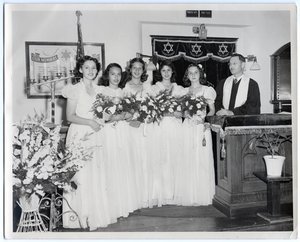Rabbi Joseph H. Gumbiner
Rabbi Joseph H. Gumbiner was born in Pittsfield, Illinois in 1907. After his ordination at Hebrew Union College at the age of 25, Gumbiner’s first rabbinical posting was in Selma, Alabama in 1931. During this time, he witnessed racial disparity and strife that would influence much of his life’s work. Numerous injustices, such as the denial of Federally funded tuberculosis treatment to Black patients, helped him understand the extent of violence and the depth of discrimination in the Deep South.
After eight years in Alabama, Gumbiner met his future wife, Sylvia, and they left for the Southwest with the agreement that he would leave the rabbinate. They opened a bookstore in Reno, Nevada.
The Gumbiners spent several years as shopkeepers, before the local Jewish community convinced “Rabbi Joe” to resume his rabbinical work and implored him to help found a Reform congregation, Temple Sinai. In 1942, a year after his daughter, Abigail, was born, Gumbiner moved the family again, this time to Tucson to serve as the head rabbi for Temple Emanu-El. In his new appointment, Gumbiner continued to speak out for civil rights and against segregation in Tucson. He was particularly appalled that Black soldiers from nearby Fort Huachuca were denied access to USO facilities, despite having served in World War II. He cultivated multi-faith and intercultural dialogue with Prince Chapel African Methodist Episcopal Church, Temple Emanu-El’s next door neighbor, and he co-founded the Tucson Inter-Racial Council, a group that laid the ground-work for the desegregation of local schools. Gumbiner also hosted a regional meeting of the Urban League in the Temple.
When knowledge of the Holocaust emerged, Gumbiner joined with Rabbi Marcus Breger of Congregation Anshei Israel to form the Tucson Zionist District. Together, they solicited donations from Jews and non-Jews alike to help relocate survivors to what would become Israel.
Gumbiner was instrumental in establishing an official Hillel on the University of Arizona campus and he arranged for the gifting of the land that would become home to the UA Hillel Foundation. He taught classes at the UA while continuing his own studies and earning a Master’s degree in Philosophy.
During the 1940s, under Gumbiner’s leadership, Temple Emanu-El grew astoundingly from 28 to 200 families. Despite this success, his history of standing up for his beliefs eventually challenged his pulpit. While many supported his interracial efforts, others thought his activism reflected badly on the Jews in Tucson. By 1947, while Temple Emanu-El’s leadership was raising money to createthe larger congregational home that eventually would be built on Country Club Road, negotiations for Gumbiner’s contract renewal grew contentious.. Though the congregation’s board voted for a three-year contract extension, Gumbiner knew that many of the larger donors would retract their pledges for the new building if he remained. To avoid causing a split in the congregation, he made the difficult decision to resign his post.
Gumbiner eventually settled on the West Coast and founded Temple Beth Hillel in North Hollywood, California. He later became the director of the Hillel Foundation at the University of California, Berkeley. All the while, he never abandoned his activist work, including heading back to the South in the 1960s to fight for desegregation. He was arrested twice: once in Jackson, Mississippi for eating lunch with Black individuals at a segregated coffee shop, and a second time for leading a demonstration in Montgomery in front of the mayor’s home. In the Bay Area he joined a contingent of Reform rabbis who marched with Dr. Martin Luther King, Jr. from Selma to Montgomery, Alabama, in 1965.
Gumbiner remained in California for the rest of his life. He retired from the UC Berkeley Hillel Foundation in 1972 and died from complications from pneumonia in 1993.
His work continues to inspire the work of Tucson Jewish Museum & Holocaust Center today.
Abigail Gumbiner Archive Interview
Temple Emanu-El Archives at TJMHC
Photo credits: Abigail Gumbiner and Gumbiner Family Collections






